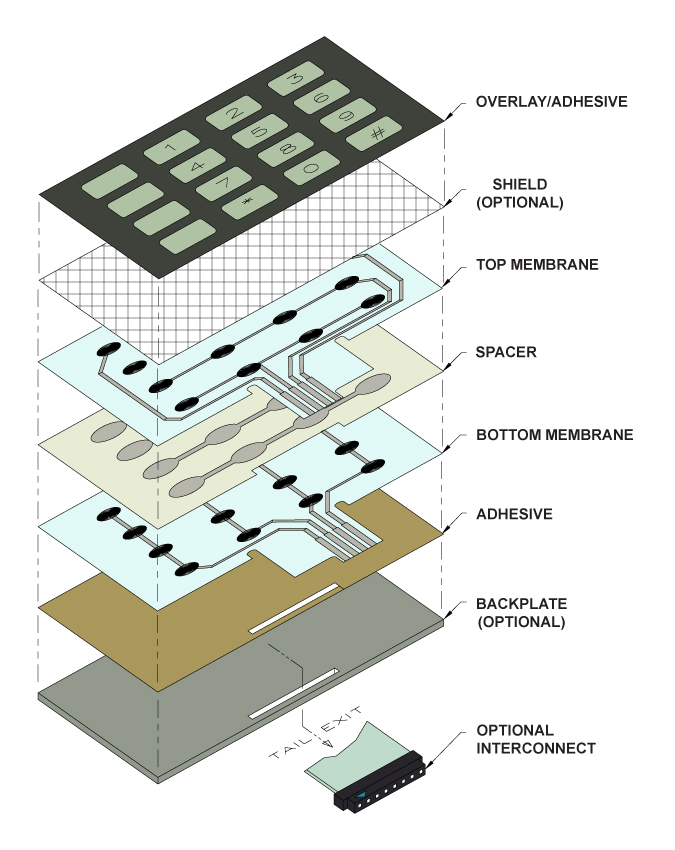Leading Advantages of Integrating a Membrane Switch Into Your Electronic Tools
Leading Advantages of Integrating a Membrane Switch Into Your Electronic Tools
Blog Article
Comprehending the Performance of Membrane Switches Over for Customer Interface Instruments
The capability of membrane switches over represents a significant development in individual interface style, incorporating efficiency with aesthetic convenience. As markets progressively prioritize user experience, comprehending the subtleties of membrane layer button innovation ends up being essential.
What Are Membrane Buttons?
Membrane buttons are innovative interface tools that assist in customer interaction with electronic tools. These functional parts include numerous layers, including a graphic overlay, spacer, and a published circuit layer. The layout permits a smooth integration right into various digital tools, enhancing both the aesthetic and useful facets of customer interfaces.
Membrane switches are commonly employed in a vast range of applications, from family appliances to commercial machinery and medical devices. Their building and construction normally includes a slim profile, making them an excellent selection for small styles. The responsive responses given by these buttons can be engineered to satisfy details customer preferences, making certain effective communication in between the individual and the device.
Sturdiness is one more significant advantage of membrane layer buttons, as they are immune to dust, dampness, and chemicals, which enhances their life-span in requiring settings. In addition, these switches can be customized in regards to form, size, and visuals layout, allowing for branding and user-specific features. Generally, membrane layer switches represent a practical remedy for improving user experience in digital devices, incorporating capability with visual charm in a reliable manner.
Exactly How Membrane Switches Job
Operating on a straightforward principle, membrane switches use a layered building and construction to register user input properly. Each switch contains numerous layers, including a published circuit layer, a spacer layer, and a leading visuals layer, which are designed to function together perfectly. When an individual presses the leading layer, it compresses the spacer layer, bringing the conductive elements of the circuit layer right into call with each various other.
This get in touch with produces a closed circuit, signaling the tool to implement a specific function. The design enables for numerous setups, including responsive feedback, which can enhance the user experience by giving a physical feeling upon activation. The materials made use of in membrane layer switches usually consist of versatile substratums, such as polyester or polycarbonate, which guarantee sturdiness and resilience versus damage.

Key Advantages of Membrane Layer Buttons

Another significant advantage is their compactness. Membrane buttons are slim and light-weight, which makes it possible for makers to save space in their tools without sacrificing capability. This function is particularly helpful in applications where weight and volume are crucial considerations.
In addition, membrane layer buttons are resistant to dust, dampness, and chemicals, improving their longevity. This strength expands their lifespan and decreases the requirement for regular replacements, leading to price savings in time.
In addition, the responsive comments offered by membrane layer buttons can be optimized to improve customer communication. They can include features such as raised switches or audible clicks, boosting usability and customer experience.
Applications Across Industries
User interface devices utilizing membrane buttons prevail in a large array of sectors, showcasing their versatility and capability. Membrane Switch. In the medical industry, membrane buttons are integral to gadgets such as analysis equipment and client surveillance systems, where their longevity and simplicity of cleansing are important for preserving health standards. In the auto sector, these buttons are utilized in dashboard controls and infomercial systems, giving a sleek and contemporary user interface for customers.
Additionally, the consumer electronic devices field gain from membrane buttons in home appliances and portable gadgets, where portable design and easy to use interfaces boost customer experience. Industrial applications also leverage membrane check this switches over for control board anchor in machinery and automation systems, highlighting their toughness and resistance to severe settings.
In the aerospace and protection industries, membrane buttons are utilized in cabin controls and tools, where integrity and efficiency under extreme conditions are critical. Additionally, the pc gaming market progressively incorporates membrane buttons in controllers and arcade devices, adding to an appealing user experience. Generally, the convenience of membrane switches allows their widespread use throughout many fields, highlighting their value in contemporary user interface style.
Future Fads in Membrane Change Innovation

Furthermore, the usage of innovative materials, such as polycarbonate and polyester films, is expected to increase, offering enhanced longevity and resistance to environmental stressors. These products add to the general long life of membrane buttons, making them appropriate for harsher industrial applications.
Additionally, the unification of wise technology, consisting of IoT connection, will certainly enable membrane switches to communicate with other gadgets and systems, facilitating an extra interactive customer experience. This pattern aligns with the growing demand for clever devices throughout numerous fields, from healthcare to consumer electronic devices.
Finally, customization alternatives are expected to broaden, permitting makers to create bespoke services tailored to specific user requirements and preferences. These advancements will certainly place membrane buttons as essential parts in the advancement of interface modern technology.
Final Thought
To conclude, membrane layer changes stand for a crucial improvement in interface technology, providing a trustworthy and versatile option for diverse digital applications. Their split construction facilitates compact style, while attributes such as responsive responses boost user interaction. The sturdiness against environmental elements better strengthens their utility throughout multiple sectors. As improvements in material science and touch sensing technologies continue, the capability and applicability of membrane layer switches are expected to expand, enhancing their relevance in modern digital gadgets.
Report this page